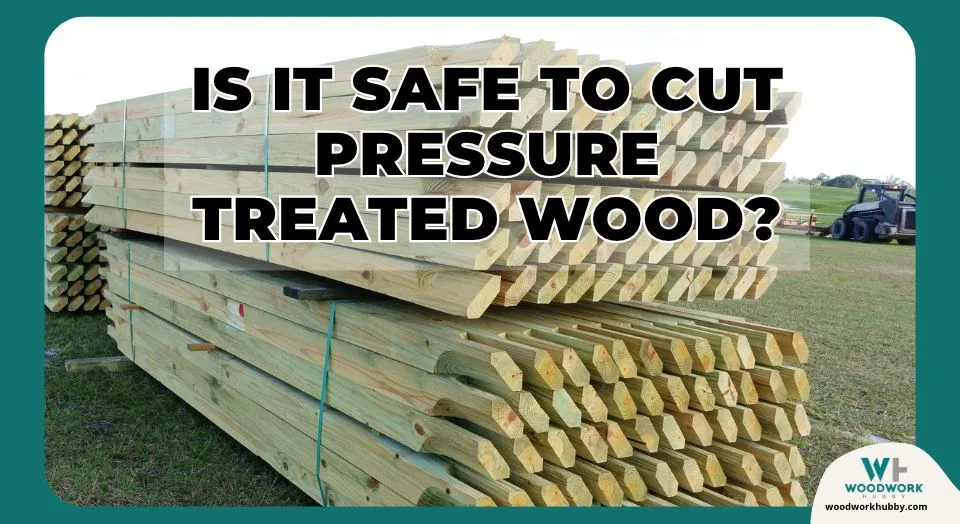Pressure treated wood is far more formidable and impact-resistant than average wood, which makes more woodworkers hesitant to cut it. Its toughened core can damage cutting tools. But there’s another reason to exercise caution when cutting pressure-treated wood. From my own experience, let me share with you the answer to the question: is it safe to cut pressure treated wood?
It is unsafe to cut pressure-treated wood without a mask or a respirator. The active ingredients in pressure-treated lumber can turn into airborne particles. These can pose multiple respiratory health risks if inhaled with any degree of consistency.
In this article, you will learn all you need to know about cutting pressure-treated wood safely. This includes an assessment of the risk factor; what can happen if you cut pressure-treated wood for a single project; and whether the lumber itself gets damaged when cut. But first, let’s look at the pros and cons of pressure-treated wood.
| Pros of pressure-treated wood | Cons of pressure-treated wood |
|---|---|
| It lasts longer than its untreated equivalent | Chemical preservatives can threaten your health |
| Prevents fungal decay and insect-driven damage | Easy to mishandle. A novice may burn or cut it without knowing the consequences . |
| It is relatively low maintenance | Can warp and shrink under some circumstances |
| It is easy to repair | Hard to work with because of its rigidity |
| It can be perfect for exterior applications | Very dangerous if it catches fire |
| It is stronger and has a higher carrying capacity | It cannot be used in food-adjacent applications |
What Happens if You Cut Pressure Treated Wood?
If you cut pressure treated wood, you open up the previously sealed/covered content at the lumber’s core. This makes the specific board, log, or sheet vulnerable to damage. More importantly, toxic airborne particles can affect your health adversely.
Let’s explore all the consequences of cutting pressure-treated wood, their respective seriousness, the likelihood of risk, and potential countermeasures.
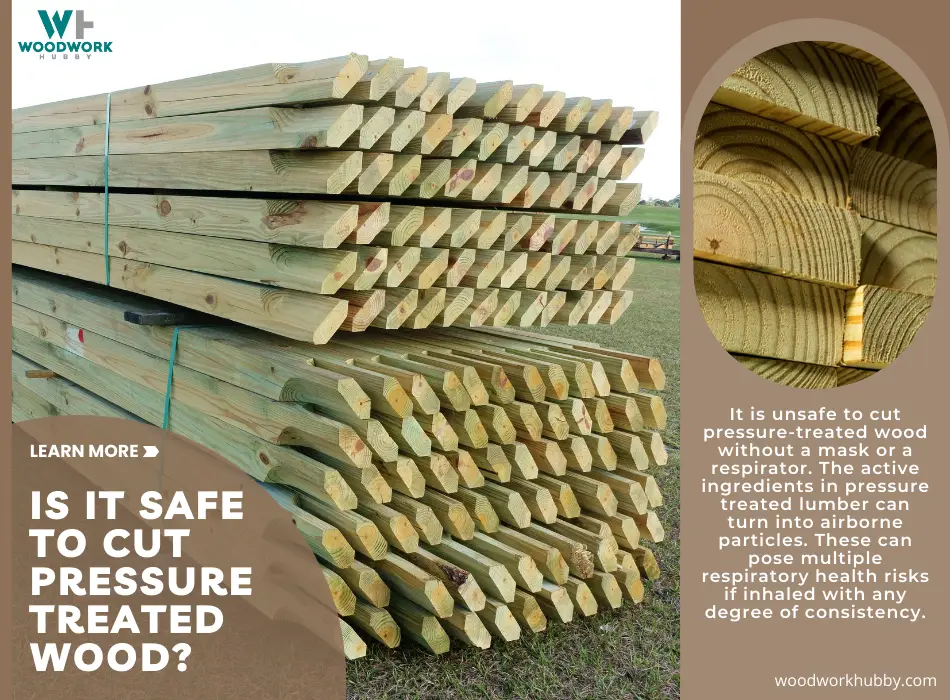
The Wood Might Become Vulnerable
Pressure-treated wood is manufactured to withstand environmental exposure. After all, the greatest reason for wood degradation is the deteriorating effect of being exposed to the elements. With chemical preservatives, such degradation can be avoided. But these chemicals don’t coat each and every particle or layer of pressure-treated lumber.
Upon sawing treated wood, you end up exposing its interior. This can turn at least a portion of the wood into regular untreated wood. As a consequence, you might find a minute degree of rot in the lumber. This isn’t a very serious effect, but it is worth countering.
To counter the vulnerability introduced by cutting the wood, you need to seal the face of the lumber. Water and moisture are some of the most significant dent-makers in the health of any wood object. While sealing a cut piece of pressure-treated lumber won’t make the exposed face as durable, it will keep all surfaces from incurring water damage.
Your Tools Can Get Blunt
Another effect of cutting pressure-treated wood is that the tools you use can lose their edge. After cutting through hard materials, sharp tools often lose their previous sharpness. This can be a very significant negative effect of cutting pressure-treated lumber if you’re on a tight budget.
Many power tools can power through pressure-treated lumber with relative ease. In my experience, this effect isn’t equally valid for all woodworkers. But fresh woodworkers that use hand tools should remain cautious.
You Can Inhale Dangerous Toxins
This is the most significant drawback of cutting pressure-treated wood. While the lumber itself is safe, active chemicals in it can become airborne alongside sawdust. If your mouth and nose aren’t sufficiently protected, your health can take a turn for the worse.
This is, without a doubt, bad. But how often does this “bad” manifest? It is not like you saw a pressure-treated wood board once and ended up in the hospital. It takes prolonged exposure to pressure-treated wood dust to get seriously ill. But the seriousness of the medical complications that arise from pressure-treated lumber cutting is enough to make one hesitate.
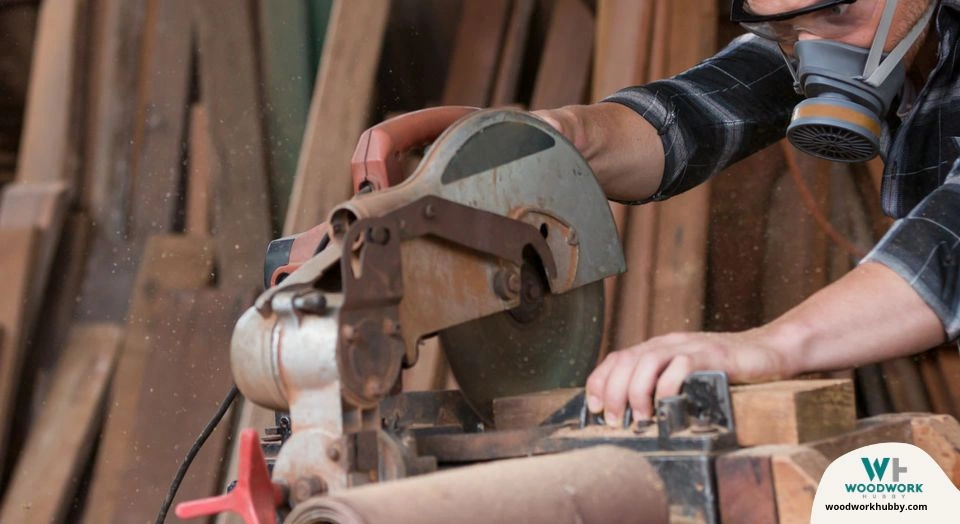
Here are some of the potential consequences of inhaling sawdust from pressure-treated wood:
- Lung Cancer
- Skin Cancer
- Bladder Cancer
These are all contingent on the presence of arsenic in pressure-treated wood. Almost all of the pressure treated wood manufactured prior to 2004 has chromate copper arsenate. There is active arsenic in the old lumber, and cutting products made from it can expose one to particularized and airborne arsenic.
To prevent the negative effects covered above, you need a respirator when cutting pressure-treated wood. Moreover, you must avoid working with lumber treated before 2004 and products made from it.
The video shows sealing pressure treated wood after cutting
Is Pressure Treated Lumber Toxic?
Pressure-treated lumber can be toxic if CCA is used in its treatment. The arsenic component of some treatments can leech onto human skin and food items, increasing the risk of various cancers. Most pressure treatment processes today do not involve CCA.
To make sure your pressure-treated lumber isn’t toxic, ask the manufacturer to provide in writing that it is CCA-free. If the seller uses online channels, this should be on the sales page or product description.
Pressure-Treated Wood Risk Reduction Practices:
When buying, handling, and cutting pressure-treated lumber, you need to make sure of the following:
- The wood is CCA-free to avoid arsenic poisoning – Some pressure-treated wood imported from eastern countries might contain CCA.
- You wear a respirator when cutting pressure treated wood – Even CCA-free preservatives aren’t healthy when particalized and airborne. It is always better not to inhale sawdust.
- Use an end sealer after cutting pressure treated wood – The interior of pressure treated wood isn’t meant to be exposed to the elements. An end sealer protects the relatively vulnerable parts of the wood.
- Don’t burn pressure treated wood – Finally, you must avoid burning wood that has chemical preservatives because it can produce toxic fumes.
The video shows the pressure treatment process
Is Pressure Treated Wood Safe for Cutting Boards?
Pressure treated wood is not safe for cutting boards, countertops, or even serving trays. It is generally used in exterior applications. The preservative chemicals in the treatment aren’t supposed to be food-safe or food-adjacent.
You’re better off choosing a food-safe wooden board and using a food-safe sealer over it. HOPE’S 100% Pure Tung Oil is an excellent finish to use for food-contact surfaces. As long as the oil is completely dry, it is non-toxic. Please keep in mind that the wood itself has to be natural and toxin-free to be safe for cutting boards.
HOPE’S 100% Pure Tung Oil
A food-safe, thick resin coat over pressure treated wood board would make the board safe for use with food. But that is a very expensive solution and not a straightforward one.
Walnut, beech, cherry, and maple are some of the best natural wood types for cutting boards. Teak and bamboo can also work for this application.
Should You Cut Pressure-Treated Wood?
You should avoid cutting pressure-treated wood if you can. Particles of hardened chemical preservatives getting airborne can cause irritation and health complications. Moreover, the lumber itself can become vulnerable, which defeats the purpose of having pressure-treated wood.
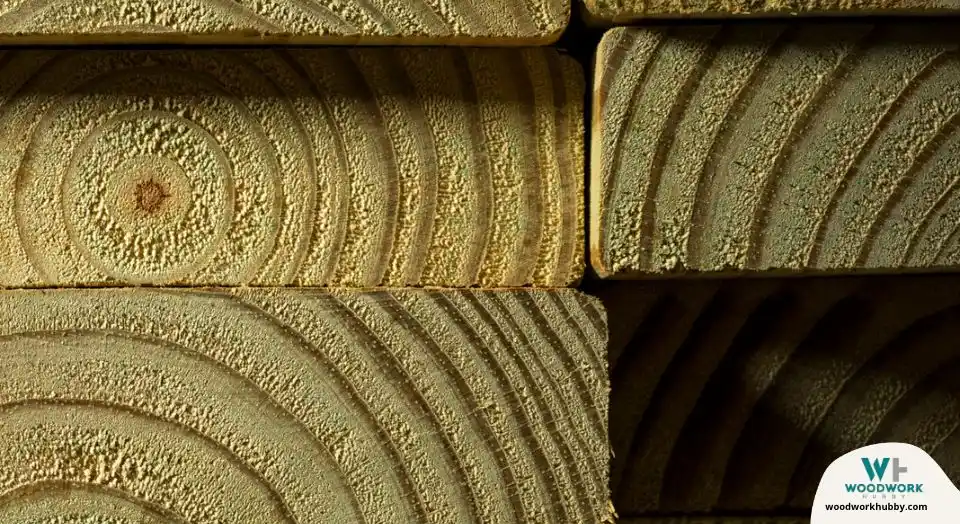
Whether you can cut pressure treated wood is an entirely different question from whether you should do it. On average, cutting pressure treated wood is possible. However, it is far from feasible.
An alternative is to get hardwood, cut it to the specifications you need for your project, then treat it with chemical preservatives at home. You can also order pressure-treated wood boards in the size you need.
If neither option is suitable, you can cut pressure treated wood, but you must make sure of the following:
- Your workshop has an excellent air filter – You cannot afford to have the sawdust from pressure-treated wood hanging around even after you’re done cutting it.
- You use sharp power tools – Hand tools have a tendency to get blunt when used on preserved wood. High-quality power tools can cut through treated lumber.
- You wear a respirator at all times – A respirator is necessary regardless of whether your pressure-treated wood boards have arsenic or not. And if they have arsenic, you really shouldn’t be cutting or even handling them.
- Wear work goggles while cutting the pressure-treated wood – hardened chemical particles shouldn’t enter your body. While inhaling them is one way of taking them in, having your eyes naked while they are airborne is another. Protect your eyes along with your nose and mouth when working out.
- There is no fireplace around the space where the wood is cut – Don’t make the mistake of cutting even a small wood board (pressure treated) inside your home where you have a fireplace. If particles of the board fall into the fireplace, they can produce very toxic ash once you light a fire. The same applies to backyards with exposed barbeque pits.
- You don’t dispose of the wood chips by burning them – Finally, you must make sure you burn wood chips from pressure treated lumber. The leftovers are supposed to be disposed of as toxic waste.
By now, you can see why it isn’t worth it to cut pressure treated wood. Though technically possible, you have to have an unrealistic level of compliance with a wide range of protective measures, including the location of cutting, what you wear while cutting, and the tools you use. And after that, you end up needing an end sealer for the cut ends.
Here’s a video showing how that’s done.
The video shows how to seal cut ends of pressure treated wood.
The quickest way to end this string of complications is to choose different lumber or get pre-cut boards that fit your project specifications.
Is Pressure Treated Wood Safe for Gardens?
Pressure-treated wood is generally unsafe for gardens, raised garden beds, and especially vegetable gardens. If chemicals leached by wood get absorbed by flowers, the adverse effects are lower than if they get into food items.
Still, that doesn’t mean pressure treated wood can be used for flower gardens either. If the wood bleeds copper into the soil, the flowers won’t bloom, and you’ll just waste seeds. There are a few varieties of pressure treated wood that can be used in gardens, at least according to their manufacturers.
Manufacturers that use micronized copper quaternary in their pressure treatment claim that their lumber is safe for use in gardens. I would take this with a pinch of salt and avoid using pressure treated wood in a garden.
Looking for facts about how long wood lasts? I’ve got you covered. Check it out!
What Is Pressure-treated Wood Used For
Pressure treated wood is mainly used for exterior applications. The chemical preservatives in pressure treated lumber make it more resilient against the elements and insects. Fungal decay, water damage, and termite infestations are not likely in pressure treated wood.
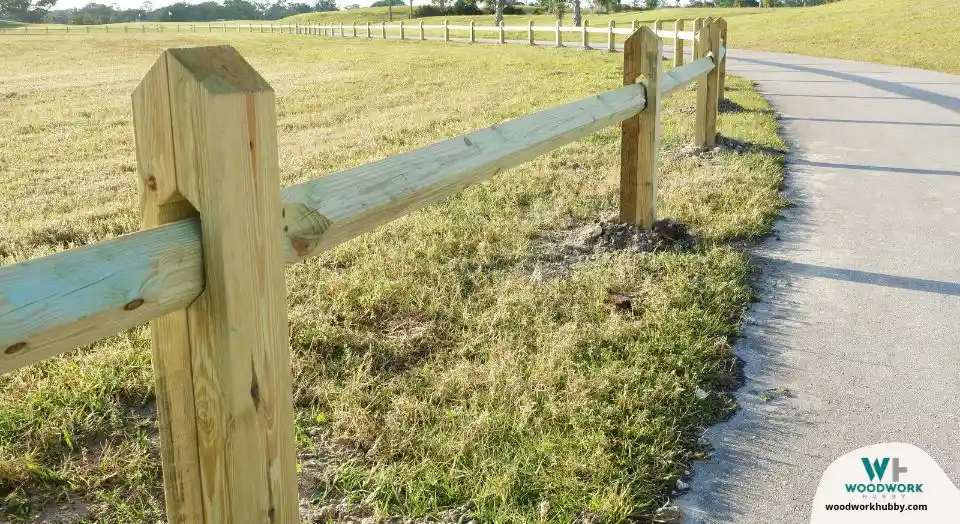
You can use it for projects like:
- Poles – Poles are in constant contact with the ground, increasing the chances of rotting and insect infestation. Pressure treatment can prevent this from happening.
- Signboards – Signboards are also vulnerable to decay and damage that comes from being pinned into the soil. While poles can be anchored into cement, signboards are usually plunged into raw earth. This increases the chances of infestation, but not if the material is pressure treated wood.
- Wall exterior – If your shed’s walls are made of wood, they might as well be made from pressure treated wood. That way, moisture in the air won’t wear out the shed wood.
- Door frames – Doors are raised, but frames are anchored into the ground. This can lead to termite infestations over time. Pressure treated wood or metal painted with a wood finish are often used to avoid that.
- Fences – Fences are as vulnerable to moisture, fungus, and termite damage as signboards. Pressure treated wood ensures that the fence doesn’t rot at its root.
- Outdoor construction in general – Pressure-treated wood is used for a variety of outdoor applications aside from the ones covered above. The rule of thumb is that if the wood comes into constant contact with water or the ground, it should be treated with chemical preservatives that can keep it from rotting.
Final Thoughts – Is It Safe To Cut Pressure Treated Wood?
Pressure-treated wood is generally safe, but not when it is cut or burned. That’s why it cannot be used for cutting boards or as firewood.
Still, you can cut pressure-treated wood if you wear a respirator and protective goggles, use sharp power tools and cut the lumber in a workshop with excellent filtration.

